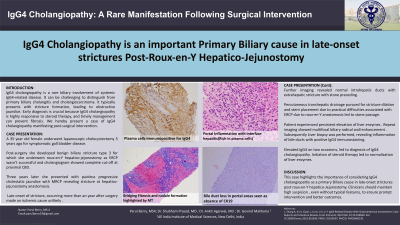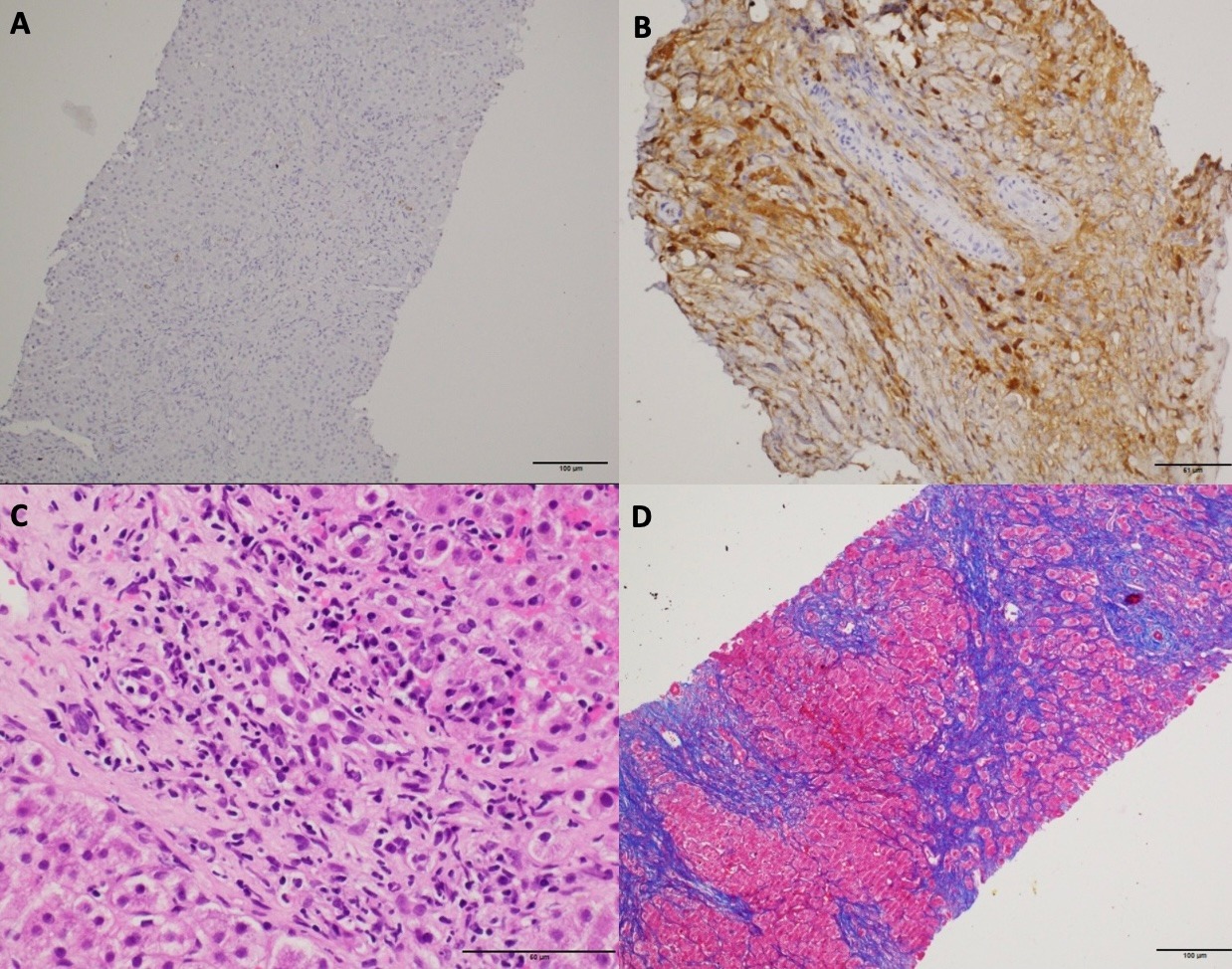Tuesday Poster Session
Category: Biliary/Pancreas
P2955 - IgG4 Cholangiopathy : A Rare Manifestation Following Surgical Intervention
Tuesday, October 24, 2023
10:30 AM - 4:00 PM PT
Location: Exhibit Hall

Has Audio

Parul Berry, MBBS
All India Institute of Medical Sciences
New Delhi, Punjab, India
Presenting Author(s)
Parul Berry, MBBS1, Shubham Prasad, MD2, Ankit Agarwal, MD2, Govind Makharia, MD, DM2
1All India Institute of Medical Sciences, New Delhi, Punjab, India; 2All India Institute of Medical Sciences, New Delhi, Delhi, India
Introduction: IgG4 cholangiopathy is a rare biliary involvement of systemic IgG4-related disease associated with pancreatitis, sialadenitis, and retroperitonitis. Distinguishing it from primary sclerosing cholangitis and cholangiocarcinoma can be challenging. IgG4 cholangiopathy typically presents with stricture formation, leading to obstructive jaundice. Early diagnosis is essential due to its high responsiveness to steroid therapy and the potential to prevent fibrosis with timely management. Here, we present a case of post-surgical manifestation of IgG4 cholangiopathy.
Case Description/Methods: A 35-year-old female underwent laparoscopic cholecystectomy 5 years ago for symptomatic gallstone disease. Post-surgery, she developed a benign biliary stricture (type 3). ERCP was unsuccessful, revealing a complete cut-off at the proximal CBD. Roux-en-Y hepatico-jejunostomy was performed. After 3 asymptomatic years, she presented with painless progressive cholestatic jaundice. MRCP revealed a stricture at the hepatico-jejunostomy anastomosis site. Late onset of the stricture made an ischemic cause unlikely. Further imaging showed normal intrahepatic ducts with extrahepatic stricture formation with a stone behind it. PTBD was pursued due to practical difficulties with ERCP in the presence of the roux-en-Y anastomosis. Stricture dilation and stent placement facilitated stone passage. However, persistent elevation of liver enzymes persisted. Extensive evaluations ruled out liver disease. Follow-up imaging showed multifocal biliary radicles wall enhancement. Liver biopsy revealed inflammation of bile ducts consistent with primary biliary duct disease and positive IgG4 immunostaining. Elevated IgG4 levels on two occasions confirmed IgG4 cholangiopathy. Steroid therapy normalized liver enzyme levels, and PTBD catheter was removed. Delayed diagnosis occurred due to absence of typical features of IgG4 cholangiopathy.
Discussion: This case emphasizes considering IgG4 cholangiopathy as a primary biliary cause in late-onset strictures post-roux-en-Y hepatico-jejunostomy. Clinicians should maintain a high suspicion, even without typical features, to ensure prompt intervention and better outcomes.

Disclosures:
Parul Berry, MBBS1, Shubham Prasad, MD2, Ankit Agarwal, MD2, Govind Makharia, MD, DM2. P2955 - IgG4 Cholangiopathy : A Rare Manifestation Following Surgical Intervention, ACG 2023 Annual Scientific Meeting Abstracts. Vancouver, BC, Canada: American College of Gastroenterology.
1All India Institute of Medical Sciences, New Delhi, Punjab, India; 2All India Institute of Medical Sciences, New Delhi, Delhi, India
Introduction: IgG4 cholangiopathy is a rare biliary involvement of systemic IgG4-related disease associated with pancreatitis, sialadenitis, and retroperitonitis. Distinguishing it from primary sclerosing cholangitis and cholangiocarcinoma can be challenging. IgG4 cholangiopathy typically presents with stricture formation, leading to obstructive jaundice. Early diagnosis is essential due to its high responsiveness to steroid therapy and the potential to prevent fibrosis with timely management. Here, we present a case of post-surgical manifestation of IgG4 cholangiopathy.
Case Description/Methods: A 35-year-old female underwent laparoscopic cholecystectomy 5 years ago for symptomatic gallstone disease. Post-surgery, she developed a benign biliary stricture (type 3). ERCP was unsuccessful, revealing a complete cut-off at the proximal CBD. Roux-en-Y hepatico-jejunostomy was performed. After 3 asymptomatic years, she presented with painless progressive cholestatic jaundice. MRCP revealed a stricture at the hepatico-jejunostomy anastomosis site. Late onset of the stricture made an ischemic cause unlikely. Further imaging showed normal intrahepatic ducts with extrahepatic stricture formation with a stone behind it. PTBD was pursued due to practical difficulties with ERCP in the presence of the roux-en-Y anastomosis. Stricture dilation and stent placement facilitated stone passage. However, persistent elevation of liver enzymes persisted. Extensive evaluations ruled out liver disease. Follow-up imaging showed multifocal biliary radicles wall enhancement. Liver biopsy revealed inflammation of bile ducts consistent with primary biliary duct disease and positive IgG4 immunostaining. Elevated IgG4 levels on two occasions confirmed IgG4 cholangiopathy. Steroid therapy normalized liver enzyme levels, and PTBD catheter was removed. Delayed diagnosis occurred due to absence of typical features of IgG4 cholangiopathy.
Discussion: This case emphasizes considering IgG4 cholangiopathy as a primary biliary cause in late-onset strictures post-roux-en-Y hepatico-jejunostomy. Clinicians should maintain a high suspicion, even without typical features, to ensure prompt intervention and better outcomes.

Figure: A: Bile duct loss in portal areas seen by the absence of CK19
B: Plasma cells immunopositive for IgG4
C: Portal inflammation with interface hepatitis rich in plasma cells and duct damage 40X
D: Bridging fibrosis and nodule formation highlighted by MT
B: Plasma cells immunopositive for IgG4
C: Portal inflammation with interface hepatitis rich in plasma cells and duct damage 40X
D: Bridging fibrosis and nodule formation highlighted by MT
Disclosures:
Parul Berry indicated no relevant financial relationships.
Shubham Prasad indicated no relevant financial relationships.
Ankit Agarwal indicated no relevant financial relationships.
Govind Makharia indicated no relevant financial relationships.
Parul Berry, MBBS1, Shubham Prasad, MD2, Ankit Agarwal, MD2, Govind Makharia, MD, DM2. P2955 - IgG4 Cholangiopathy : A Rare Manifestation Following Surgical Intervention, ACG 2023 Annual Scientific Meeting Abstracts. Vancouver, BC, Canada: American College of Gastroenterology.
